A BIRTHDAY SALUTE TO THE KING: Fred Van Lente pits Kirby’s best against Kirby’s best…
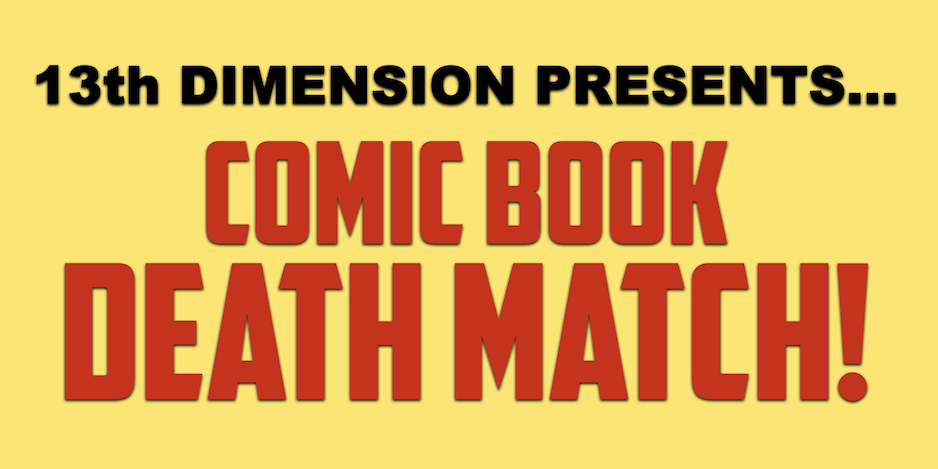
—
COMIC BOOK DEATH MATCH is a recurring column by Fred Van Lente in which the comics writer/historian takes two classic, related titles and compares them in verbal bloodsport. Actually, it’s not that serious at all. It’s FUN!
—
This year, for the late Jack Kirby’s birthday — he was born 106 years ago on Aug. 28, 1917 — we have a trio of tributes by an all-star line-up of Kirbyites: Peter Stone, Fred Van Lente and Chris Ryall, each with their own take on the King’s legacy. The links are at the bottom of the column, so by all means check ’em out. Long live the King! — Dan
—
By FRED VAN LENTE
Welcome to a very special Jack Kirby’s Birthday edition of Comic Book Death Match! I have surveyed a different segment of the King of Comics’ storied career for the last few years on August 28: previously, you’ve gotten the TOP 13 of his Fourth World comics, the TOP 13 of his post-Fourth World DC creations, and the TOP 13 of his return to Marvel in the 1970s.
Now that my travels back in time have reached the hey day of his tenure at ’60s Marvel I thought I’d try something a little bit different. Fantastic Four has long been my favorite Kirby Marvel book, ever since I first discovered it and the House of Ideas’ other flagship titles in the Pocket Books reprint series; but Kirby himself said (after he left) that Thor was his personal favorite Marvel book to work on.
So I figured, what the heck, let’s pit Jack’s and my favorite titles against each other in a month-by-month re-read with pub data from our pals at Mike’s Amazing World of Comics and see which is better. Be forewarned, I didn’t choose these monthly selections at random; I picked significant moments in Marvel history with the help of John Morrow’s essential Kirby & Lee: Stuf’ Said!, the definitive oral history of Stan and Jack’s collaboration and ’60s Marvel.
Verily, Face Front, True Believer, and prepare to have the hallowed halls of Marveldom Assembled shaken asunder as two truly titanic titles clash for your reviewer’s love! The World’s Greatest Comics Magazine and the Mighty God of Thunder:
Fight!
—
Fantastic Four #6: “Captives of the Deadly Duo!”
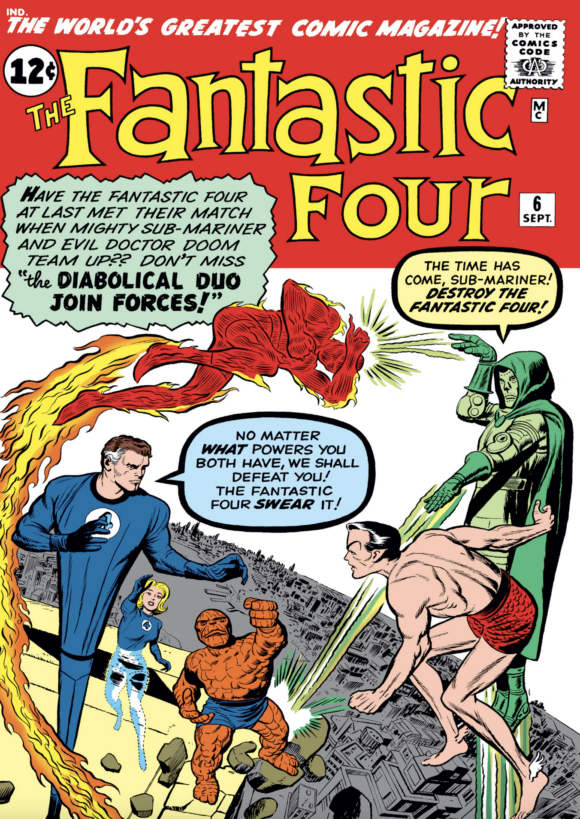
Where to begin? In this issue we get the first cutaway view of the Four’s HQ in the Baxter Building, the first mean Yancy Street Gang letter, the first mention of “Unstable Molecules,” and the second appearance of Dr. Doom, who gets Sub-Mariner to renew his crusade of vengeance against the surface world. Doom just happens to want to start this crusade at the Baxter Building. Kill these four, then the other 7,999,996 will be a breeze, I guess.
SM waltzes into the BB to confront the FF, where Torch has discovered a glam photo of Namor among his sister’s stuff, which the little twerp burns in front of her. Namor plants a magnetic device of Doom’s, who of course promptly double-crosses Subs by blasting him and the BB into outer space. Even though Thing starts beating up Namor just on principle, Subby shoots himself out of a water storage tank to bounce off meteors and kick Doom’s ass, sending him spiraling out into space.
This comic book slaps, as the kids say.
There’s an extensive article in Jack Kirby Collector #61 that argues, from available evidence, that Kirby plotted, drew and dialogued this comic by himself, as evidenced from terrific sequences like Subby launching himself off the Baxter Building toward Doom’s tug-rocket: “Go…go…GO!!”
—
Journey into Mystery #83: “Thor the Mighty and the Stone Men from Saturn!”
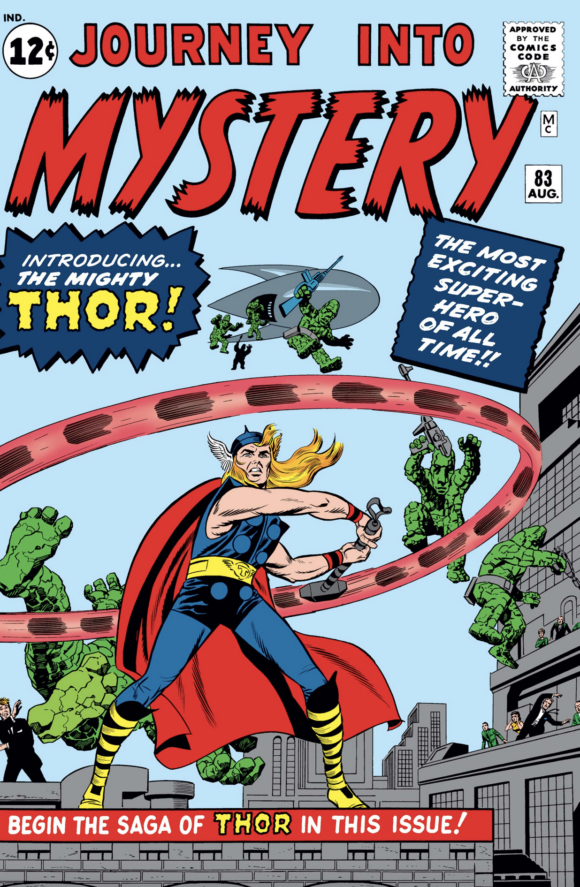
Therefore, apparently, Stan Lee didn’t script either of this month’s featured titles, as Lee cedes writing duties for Thor’s first appearance to his kid brother Larry—perhaps because Lee saw that the end result was not all that great. The stone men are rejects from Kirby’s beloved SF pulps, Thor is clearly a Superman knockoff, ripping off the Man of Steel’s color scheme and wimpy alter-ego. The whole strip feels like an afterthought, filler for a publisher desperate to pump this new FF-inspired superhero fad dry. (Amazing Fantasy #15 also comes out this month, with a far superior debut.)
The only really mighty thing about the Mighty Thor in his first appearance is his hammer. This is a Swiss Army Knife of a magic weapon that grants flight, flattens aliens, and transforms nerds into heroes. Visual elements like this are what happen when you hand artists the wheel of your superhero line, kids.
WINNER: GO! GO! GO! FANTASTIC FOUR!
—
Fantastic Four #20: “The Mysterious Molecule Man!”
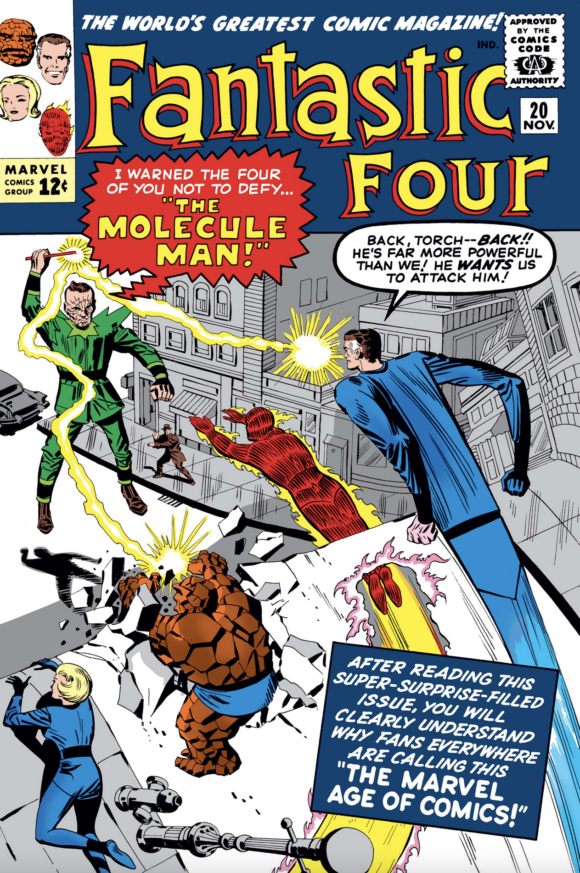
The Watcher sends a blue spiky ghost ball into the city that freaks everyone out but summons the FF, who attack it until they realize they just need to just jump into it to be transported to the Blue Area of the Moon. Pure Kirby Logic if I ever heard it. The Watcher informs them that some nebbish has lab-accidented himself into controlling all the molecules. After his standard I-Really-Shouldn’t-Be-Interfering shpiel, Big Head siccs the Four on him.
Molecule Man uses his god-like powers to humiliate our heroes over several pages—my favorite bit is when he mummifies Sue with papers from a newsstand. Realizing their new foe can’t rearrange organic matter because, gross, Reed gets Alicia Masters to cover them in clay so they look like statues. Molecule Man tries to zap them, the organo-feedback stuns him, and the blue spiky Rover whisks him away into the Watcher’s Non-Interference Space Prison. Yes, it’s all pretty silly.
—
Journey into Mystery #97: “The Mighty Thor Battles…the Lava Man!” & “Tales of Asgard!”
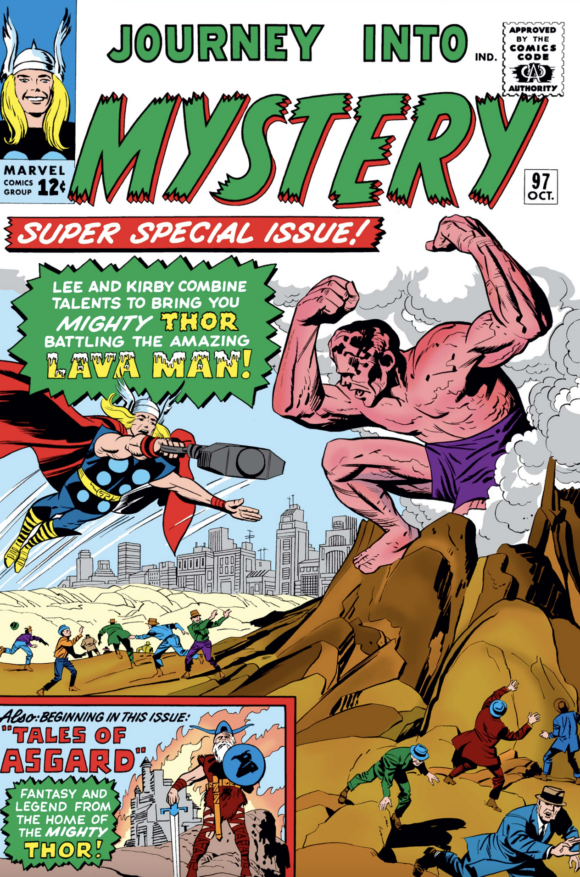
Loki has forgotten (!) about a Lava Man he summoned to Midgard until a volcanic eruption awakens said Lava Man, so Thor has to beat him up. The end.
Thor’s strip chugs along for its first few years with by-the-numbers superhero tales like this, often scripted by Larry Lieber and Robert Bernstein, a writer best known for co-creating General Zod and the Phantom Zone in Adventure Comics’ Superboy strip. (Bernstein signed his Thor work “R. Berns” so DC wouldn’t know he was scribing for the enemy.) Lee and Kirby reunite on this issue, but the results are no improvement. For one thing, Don Heck’s inks largely overwhelm Kirby.
The only noteworthy thing about this issue is a brand-new feature that replaces the old science fiction horror shorts that had been reprinted in the back. Tales of Asgard will “adapt” Norse legends strained through Kirby’s gonzo cosmic sensibilities. (In 1998, as cited in Stuf’ Said, Stan Lee said Kirby came up with 90% of the Tales plots on his own.) That said, this inaugural entry is a pretty straightforward depiction of the Scandinavian creation myth, with its magic cows and world trees. Judging by the effusive praise heaped on it in the letter columns, though, Tales of Asgard shortly becomes the most popular feature in Journey into Mystery.
WINNER: DRAW
—
By now, according to Stuf’ Said, Kirby is writing extensive dialogue notes in the margins of his original art. Lee mostly follows Kirby’s directions/suggestions, though as editor-in-chief Lee of course has final say. Lee retains sole writing credit for most of the stories, though, which leads to friction not just with Kirby, but Spider-Man and Dr. Strange co-creator Steve Ditko, who is also plotting his own titles.
Fantastic Four #29: “It Started on Yancy Street!”
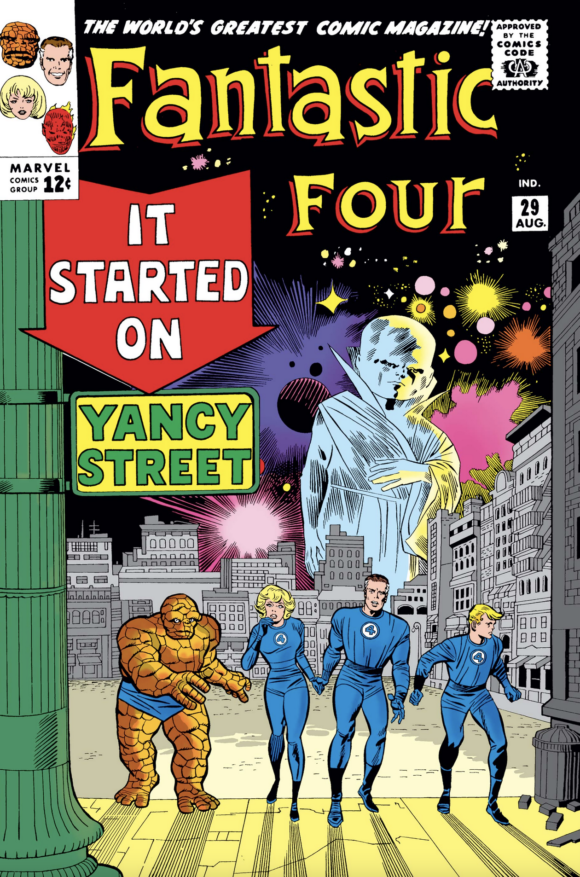
The Yancy Street Gang, introduced as a throwaway gag in #6, undoubtedly by Kirby (who grew up on the Lower East Side, the main drag of which is, of course, Del(y)ancey Street), has morphed into FF-hating pre-Banksy street pranksters. Reed is convinced an old enemy is masterminding them, and, sure enough, on Yancy Street they are attacked by the Red Ghost and his Super-Apes, an idea the gorilla fetishists at DC must have kicked themselves for not thinking of first.
Like the FF, the Socialist Simians got their powers via cosmic rays in mid-spaceflight, and their master has not given up his dreams of making the Moon safe for Communism. He drags the FF along for the ride for some reason, our heroes rebel midway, and they crash near the Watcher’s house on the Blue Area.
The Watcher isn’t home, but he has an out-of-office message that tells Reed not to touch any of his stuff. Fortunately, Reed obeys this rule as closely as the Watcher obeys his rule to Not Interfere in Mortal Affairs, and ET tech is used to vanquish the Marxist Monkeys.
So much happens in these early FF issues I could write an article on each one; I’m having a tough time condensing them.
—
Journey into Mystery #106: “The Thunder God Strikes Back!” / “Balder the Brave”
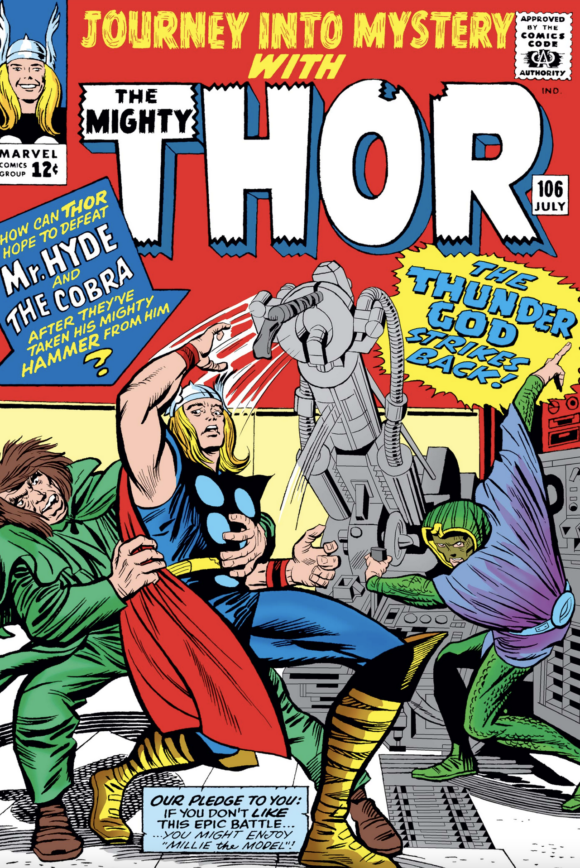
There are few Marvel villains more blah than Cobra and Mr. Hyde, and here they double their mediocrity to destroy Thor by getting his hammer stuck in an “advanced grappling machine.” In 60 seconds, of course, Thor turns back into Don Blake, who loses himself in the crowd of screaming Advanced-Machine enthusiasts at the Advanced Machine Exhibit to double back and retrieve his now-cane. A fun echo of the Thor/Blake situation occurs when Hyde lets himself turn back into loser criminal chemist Calvin Zabo to slip away from the cops, only to drink his mad-juice and re-transform to get the drop on Thor. Thor beats the snot out of him anyway.
This month’s Tales of Asgard is a re-telling of arguably the most famous Norse myth, the death of Balder at the schemes (if not the hands) of Loki. Except, to keep the whole thing in Marvel continuity, in Kirby’s version Balder lives and Loki isn’t involved at all. Vince Colletta’s loose, scratchy inks on this segment are in brutal contrast to Chic Stone’s powerful linework on the lead feature. Sometimes I don’t get the Colletta hate from Kirby fandom, but this is not one of those times.
WINNER: FF
—
This is arguably the most pivotal month in early Marvel history, both on and off the comics racks. Behind the scenes, the infamous New York Herald article hits newsstands with a Marvel feature that praises Stan Lee as a genius and Jack Kirby as “the assistant foreman in a girdle factory.” Though it’s not Stan’s fault, this is the first nail in several years’ worth of coffin-hammering that culminates in Jack defecting from the company he helped put on the map.
But on the stands, we have nothing but awesome:
Fantastic Four #49: “If This Be Doomsday!”
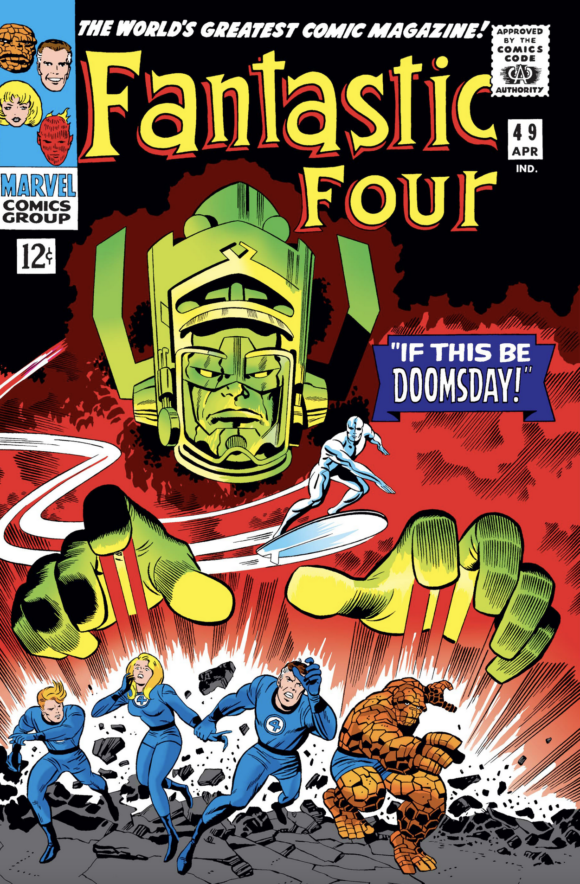
Part Two of the famed “Galactus Trilogy” sees the Fantastic Four mostly impotent against the G-Man’s awesome power. Last issue, the Thing greeted the Silver Surfer’s first appearance by punching him across town. Karma is a bitch, because Surfer lands on the rooftop of Alicia Masters, Thing’s gal pal, who instantly takes a shine to this shiny visitor from the stars. Shockingly, the Watcher throws his don’t-interfere edict to the wind and sends the Human Torch after the Ultimate Plot Device which is the only thing that can stop Galactus. The remaining three heroes try to bust up the planet-eating machine on the roof of their house.
This leads to the arrival of the character find of January 1966, the Punisher, G-Man’s stocky alien robot with three toes, who windmills Ben Grimm into submission.
—
Thor #126: “Whom the Gods Would Destroy!” / “The Summons!”
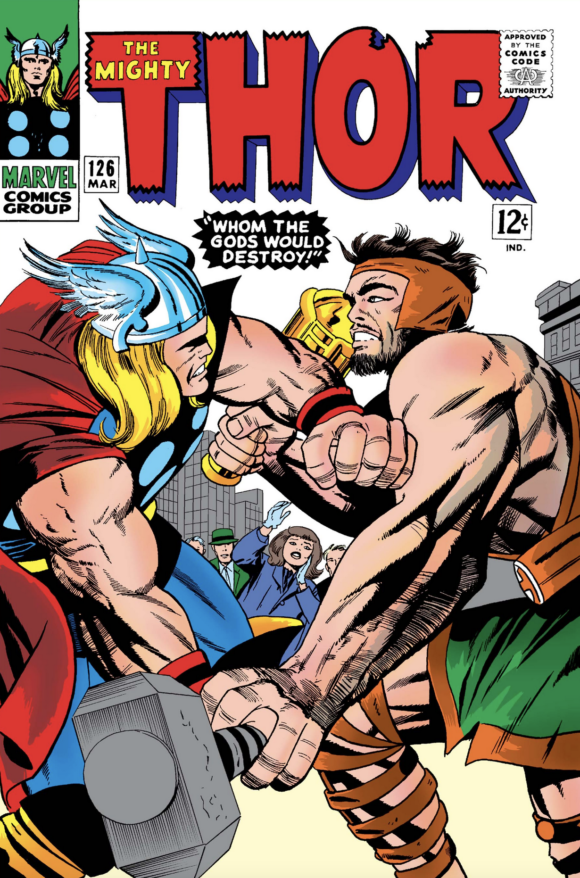
Though my personal affinity for everyone’s favorite skirt-wearing Prince of Power is well-documented, I swear I’m being purely objective when I say it’s the arrival of Hercules that finally puts the Thor title on the path to greatness—fittingly, Herc stars in the first issue to lose the Journey into Mystery moniker.
It’s not so much that the low-impulse-control Hercules is such a great foil for the square-jawed Thunder God—Kevin Feige & Co in the MCU wisely gave Chris Hemsworth’s movie Thor the comics Hercules’ personality—but that Herc brings Zeus, Olympus, and all the other Greek gods with him, expanding Thor’s milieu beyond Midgard and Asgard, freeing him to adventure across all of humanity’s pantheons, and the larger universe they portend.
Though Thor beats up costumed bank robbers from time to time during the remainder of Kirby’s run, the strip becomes the breeding ground for the clash of cosmic mythologies that would come to define the creator’s career.
Also: Tales of Asgard has flying trolls! Good stuff.
Still, though: Galactus Trilogy.
WINNER: FF
—
Steve Ditko has quit Marvel over lack of full recognition for his creations; not coincidentally, the credits on FF and Thor shift to “by Stan Lee and Jack Kirby” moving forward. Still, the boss remains the boss, as we shall see…
Fantastic Four #67: “When Opens the Cocoon!”
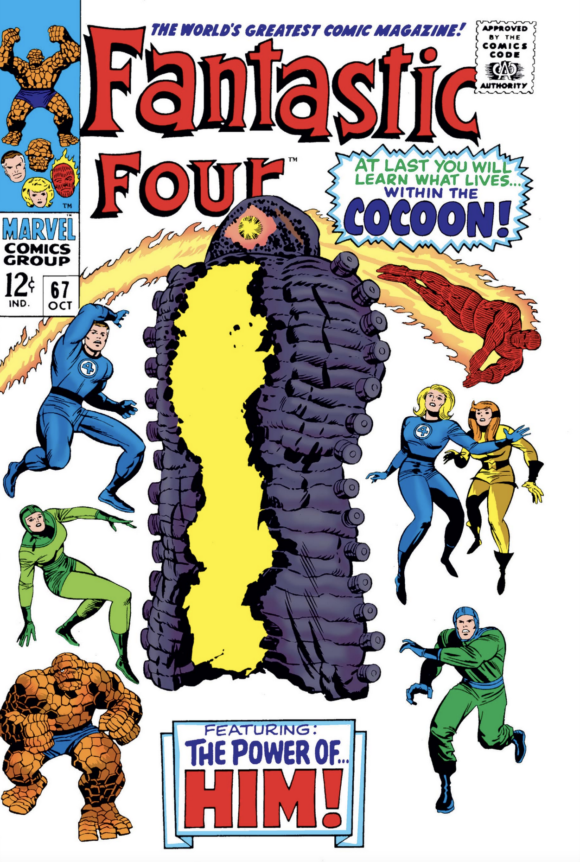
We know from the aforementioned dialogue notes on the original art that Kirby intended the character of Him, later to be renamed Adam Warlock by Roy Thomas, to be a critique of the Objectivist beliefs of the departed Mr. Ditko. Created by the arrogant scientists of a secretive Enclave, Him is a “superior being” who decides his creators are decidedly not and promptly destroys them when He emerges from His cocoon. If the Enclave hadn’t kidnapped Alicia Masters to sculpt Him’s face, the Fantastic Four wouldn’t have even been around to try and save the day.
Lee changes Kirby’s intentions in the final dialogue, however: In his hands, the Enclave becomes just another band of would-be world-conquerers and Him another Silver Surfer-style space hippie who is born innately good and pure and of course he wants to vanquish His creators because they’re eeeeeeevil.
I couldn’t tell you how radically Lee’s re-interpretation of these basic philosophical underpinnings altered Kirby’s story; there’s a lot of cool stuff in here, though this is basically an episode of The Adventures of Alicia Masters, Sculptress, with the FF as key supporting players.
Kirby, however, was pissed, enough so that he stopped creating original characters in the pages of Fantastic Four for years—according to Stuf’ Said, the next and last “significant” player Kirby would add to FF would be part-time nanny, full-time witch Agatha Harkness, in #94 (October 1969).
—
Thor #144: “This Battleground Earth!” / “The Beginning of the End!”
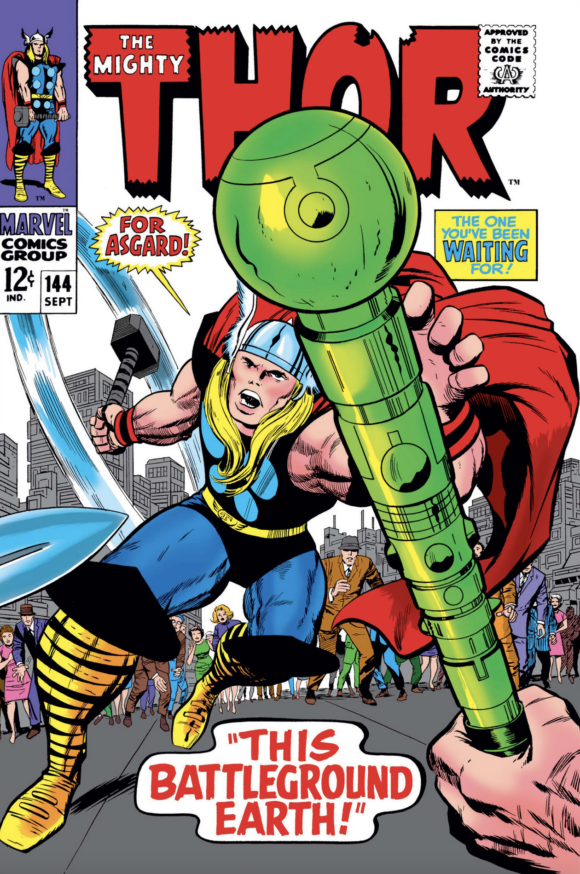
(Mike’s Amazing World says this ish and #143 both came out a month before, and there’s no Thor in July, so I am fudging the chronology slightly.)
The Enchanters, armored wizards empowered by Kirby Dot-encircled Living Talismans embedded in their chests like proto-Arnim Zolas, challenge Thor on Earth and Odin in Asgard. While in the penultimate installment of Tales of Asgard, the Thunder God and the Warriors Three beat back “Satan’s dreaded Demon Riders,” conjured by a flying carpet-riding warlock.
Stan Lee has said they discontinued Tales because Kirby ran out of ideas, and while Stuf’ Said throws salt on this claim, I’m inclined to believe him: This is less Kirby Norse Mythology than Kirby Arabian Nights.
That doesn’t mean it’s not totally awesome, though.
WINNER: THOR
—
Perfect Film & Chemical buys Marvel Comics from Martin Goodman for $15 million; part of the deal is Stan Lee will stay on as spokes-editor. The Kirby family plans to move to Southern California for the health of their youngest child, so the gulf between Jack and Stan will soon be physical and metaphorical, which, needless to say, doesn’t help.
Fantastic Four #79: “A Monster Forever?”
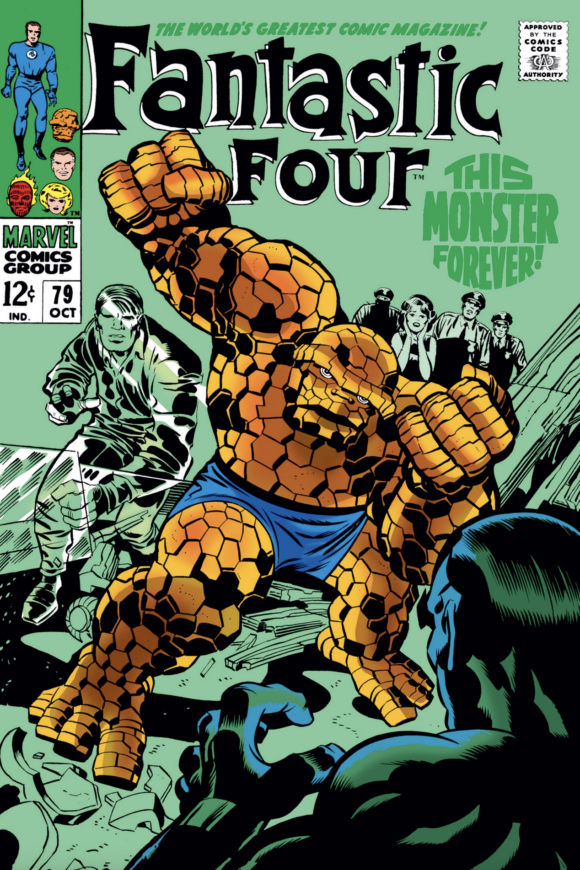
The Thing is turned back to Ben Grimm—yes, again—but his first date out with Alicia is ruined by an accidentally awakened “Android Man,” pre-programmed by the Mad Thinker to kill him, whether he’s covered in orange rocks or not. Conveniently, Ben has brought with him a gadget from the Wizard who turns him rocky again for some reason. He walks away real sad.
Except for the interesting subplot that Reed is increasingly concerned that the cosmic rays in Sue’s body may negatively affect her pregnancy, there’s not a lot here we haven’t seen before, though Joe Sinnott’s inks ensure everything looks, well, fantastic.
—
Thor #156: “The Hammer and the Holocaust!”
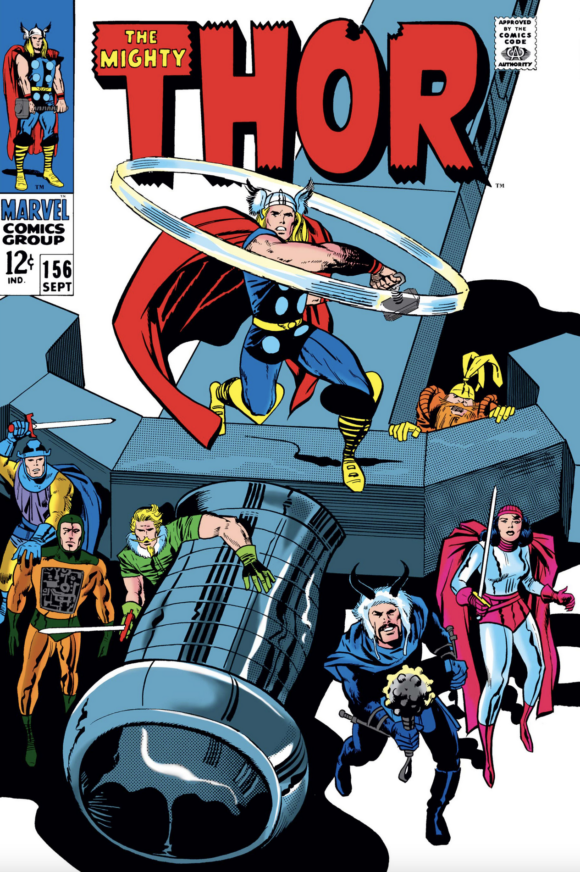
You just know there’s a cosmic-level threat in this issue because that’s a really freaking big sword on the cover, man. Mangog is the Kirbyiest Kirby monster to ever Kirby, the gigantic clawed embodiment of a billion billion aliens genocided millennia ago by Odin for what I’m sure were very good reasons. Awakened by Ulik the Troll, Mangog has been whipping the asses of everyone in the Nine Worlds on his revenge-march toward the All-Father, who has chosen the wrong time to do his Michael Jackson-esque longevity treatments, aka the so-not-in-Norse-mythology “Odinsleep.” Loki seizes the throne of Asgard while Thor and the Warriors Three valiantly, though ultimately futilely, try to keep Mangog at bay. This is the mid-point of one of the great Kirby Thor sagas.
WINNER: THOR
—
Fantastic Four #92: “Ben Grimm, Killer!”
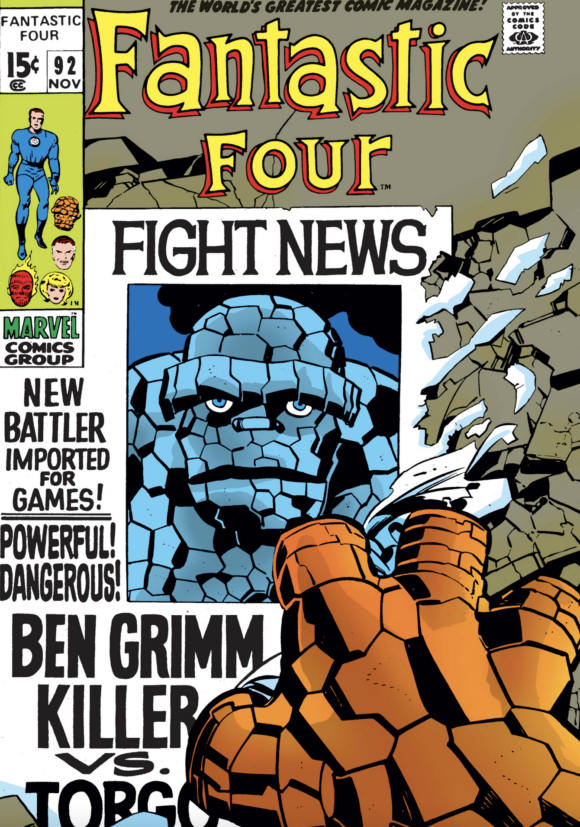
It’s hard not to come to the conclusion that Kirby has lost interest in Fantastic Four. His plots keep ripping off—uh, getting inspired by TV shows. Earlier in 1969 we saw a Latveria clearly modeled after The Village from The Prisoner (albeit awesomely); here the Thing is trapped on an alien world which copied their society off Jazz Age gangsterism, itself a copy of the second-season Star Trek episode “A Piece of the Action,” which first aired over a year and a half before. Ben gets mind-controlled into fighting a bunch of aliens in gladiatorial combat while Reed tries to retro-fit a Skrull saucer to go save him.
—
Thor #169: “The Awesome Answer!”
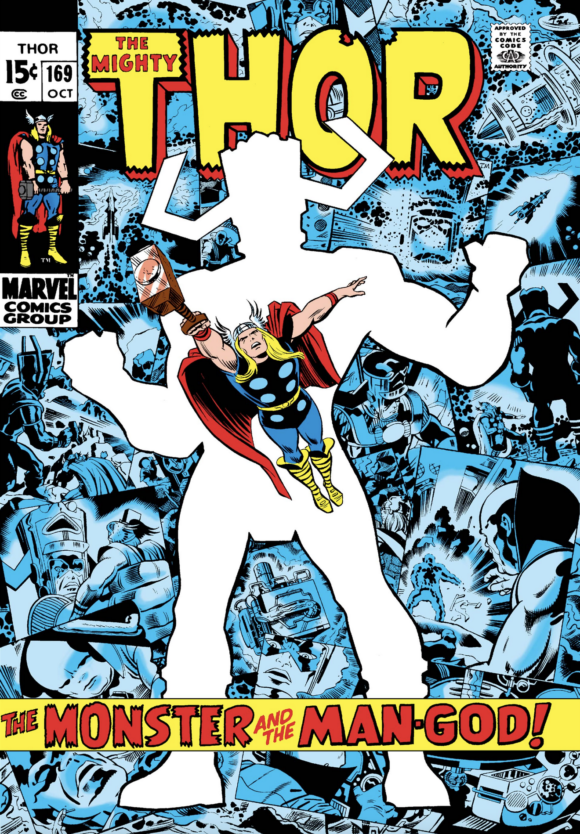
Thor is clearly Kirby’s current number-one boy because he chooses to portray the origins of Fantastic Four mainstays Galactus and The Watcher here, instead of in FF. Many eons ago, the planet Taa was ravaged by plague. Taa’s head scientist would rather die in the heart of their sun than by disease (uh, OK?), and so flies a spaceship right into it. But he doesn’t die! Instead he crash lands on a rocky planetoid, observed by the Watcher.
According to Stuf’ Said, Kirby’s original intent was that the Watcher revives the dying scientist, in the process accidentally giving G-Man the munchies for worlds. The Watcher then declares that he will never, ever, ever again interfere in galactic affairs (nudge, nudge, wink, wink).
There was just one problem with Kirby’s plan: Stan Lee had already told the Watcher’s origin with Gene Colan over in The Silver Surfer #1, a year-old comic starring a Kirby creation that he neither drew nor, apparently, read. So Lee made Kirby completely redo this story so it’s cosmic mush. (No doubt even more gallingly to Kirby, The Silver Surfer tanks sales-wise, so much so that Stan gives Jack full rein over the title’s last issue.)
Jack was likely planning on leaving Stan already, but this fiasco ensures Thor suffers the same fate as Fantastic Four: Kirby begins reserving all his new ideas for his gestating Fourth World titles, and his Marvel books peter out as retreads.
WINNER: DRAW
—
A pall falls over Marveldom Assembled in March, when Kirby calls Lee and quits. These are Kirby’s last issues.
Fantastic Four #102: “The Strength of the Sub-Mariner!”
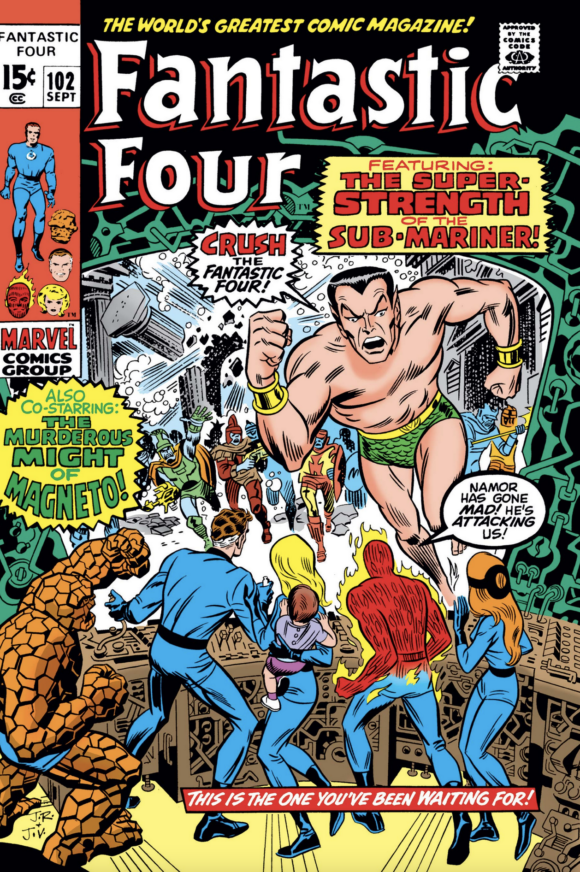
This is a bizarre hash of a comic. Subs stumbles upon the Savage Land (per Kirby’s usual contempt for other creators’ continuity, no mention is made of Namor’s own long-running series, currently on the stands), where he discovers a wounded Magneto, still not fully recovered from X-Men’s relegation to reprint-only status. Being a giant dick, Magneto takes advantage of Namor’s hospitality by secretly using Atlantean gadgets to project his magnetic powers onto Manhattan, wreaking havoc and tricking the FF into attacking. The final panel promises “WAR!” between land and sea next issue, but, as the fact John Romita drew this cover could have told you, Jack Kirby will be a conscientious objector.
—
Thor #179: “No More the Thunder God!”
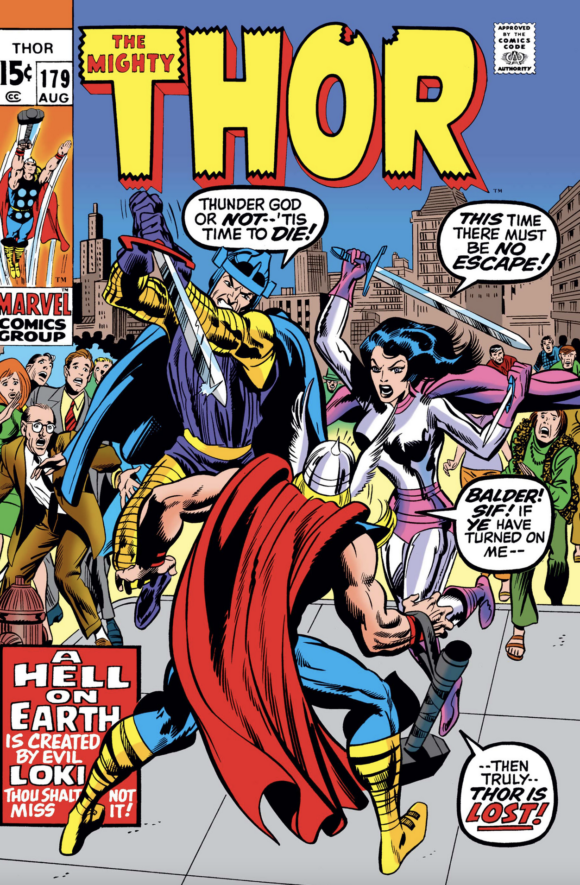
Having defeated Surtur the issue before, Thor returns to the Big Apple only to have his mug swapped with Loki’s. Balder and Sif inconveniently arrive to be duped by the Face/Off, but discover Thor’s true nature when he expresses dismay at Balder’s seeming demise. Neal Adams, who provides this month’s cover, will complete this storyline starting next issue.
The Kirby Era at Marvel ends with a decidedly un-cosmic whimper.
WINNER: THOR
—
The evidence is pretty clear: In the first half of the ’60s, Kirby’s creative energy went into Fantastic Four; when that ardor cooled in the decade’s second half, Thor was the beneficiary of his genius. I came to FF first so liked it more; Kirby left Marvel on a high note with Thor, and liked that most. But clearly, the only true winner here is we, the readers.
OVERALL WINNER: DRAW
Hail to the King!
—
MORE
— THE NEAL ADAMS CHRONICLES: Mapping Out NEAL ADAMS’ Enduring Respect and Admiration for JACK KIRBY. Click here.
— Dig These 13 Unpublished JACK KIRBY MARVEL Covers. Click here.
—
13th Dimension contributor emeritus Fred Van Lente is a comics writer, historian and playwright. His play with Crystal Skillman, King Kirby, is available here.

August 28, 2023
Vinnie Colletta added such a unique and realistic layer to whatever he inked and Thor was a prime example. Chic Stone inks merely resembled the rest of the heavy line inkers such as Giacoia and Royer. Perhaps detailing isn’t your cup of tea but, artistically speaking, Colletta’s inks elevated Kirby’s art more than any other collaborator.
August 28, 2023
Ed, I respect your opinion but you might have to search for a long time to find someone who agrees with your take on Colletta. His sparse inks seemed to work on Kirby’s Thor (I’m not sure why they did) but he was a detriment to every other artist and book he ever worked on. Joe Sinnott was the inker who brought out the best in Kirby.
September 1, 2023
Search no further, I’m with Ed (except for Giacoia whom I loved.) I had no interest in Kirby until I saw him inked by Colletta. When Colletta left the Fourth World, I left too.
Happy Trails,
Smitty
September 2, 2023
Uhh… that last Thor cover looks like Adams over a Marie Severin layout. Gonna check GCD…
And I’m partly correct: Adams pencils, Verpoorten inks, additional background art by John Romita. Nothing about who did the cover design but I’ve never seen such a credit at the GCD.